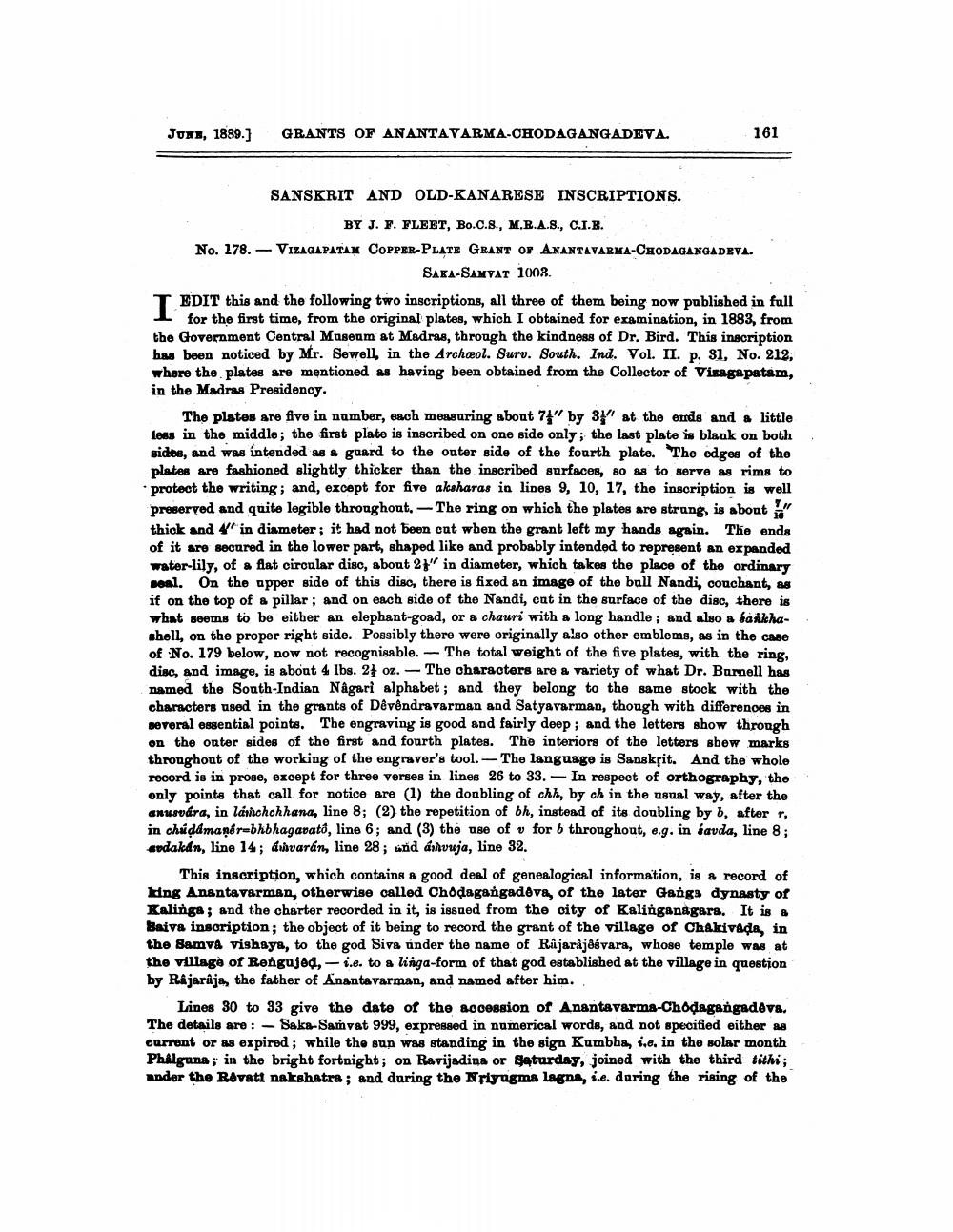________________
JUK, 1889.)
GRANTS OF ANANTAVARMA-CHODAGANGADEVA.
161
SANSKRIT AND OLD-KANARESE INSCRIPTIONS.
BY J. F. FLEET, Bo.C.S., M.R.A.S., C.I.E. No. 178. — VIZAGAPATAM COPPER-PLATE GRANT OF ANANTAVARMA-CHODAGANGADEVA.
SAKA-SAMYAT 1003. T EDIT this and the following two inscriptions, all three of them being now published in full
for the first time, from the original plates, which I obtained for examination, in 1883, from the Government Central Museum at Madras, through the kindness of Dr. Bird. This inscription has been noticed by Mr. Sewell, in the Archeol. Surv. South. Ind. Vol. II. p. 31, No. 212, where the plates are mentioned as having been obtained from the Collector of Visagapatam, in the Madras Presidency.
The plates are five in number, each measuring about 7" by 8y" at the ends and a little leas in the middle; the first plate is inscribed on one side only; the last plate is blank on both sides, and was intended as a guard to the outer side of the fourth plate. The edges of the plates are fashioned slightly thicker than the inscribed surfaces, so as to serve as rims to protect the writing; and, except for five aksharas in lines 9, 10, 17, the inscription is well preserved and quite legible throughout. -The ring on which the plates are strang, is about ! thick and ' in diameter; it had not been cut when the grant left my hands again. The ends of it are secured in the lower part, shaped like and probably intended to represent an expanded water-lily, of a flat circular disc, about 21" in diameter, which takes the place of the ordinary peal. On the apper side of this disc, there is fixed an image of the ball Nandi, couchant, as it on the top of a pillar; and on each side of the Nandi, ent in the surface of the disc, there is what seems to be either an elephant-goad, or a chauri with a long handle ; and also a baskhashell, on the proper right side. Possibly there were originally also other emblems, as in the case of No. 179 below, now not recognisable. - The total weight of the five plates, with the ring, disc, and image, is about 4 lbs. 2} oz. — The characters are a variety of what Dr. Bamell has named the South Indian Nagari alphabet ; and they belong to the same stock with the characters used in the grants of Devendravarman and Satyavarman, though with differences in several essential points. The engraving is good and fairly deep; and the letters show throngh on the outer sides of the first and fourth plates. The interiors of the letters sbew marks throughout of the working of the engraver's tool. -The language is Sanskrit. And the whole record is in prose, except for three verses in lines 26 to 33. In respect of orthography, the only points that call for notice are (1) the doubling of chh, by ch in the usual way, after the anusvára, in larichchhana, line 8; (2) the repetition of bh, instead of its doubling by b, after , in chúddmaņêr-bhbhagavato, line 6; and (3) the use of v for b throughout, e.g. in savda, line 8; avdakdn, line 14; davarán, line 28; and anavuja, line 32.
This inscription, which contains a good deal of genealogical information, is a record of Hng Anantavarman, otherwise called Chodagangadáva, of the later Gangs dynasty of Kalinga; and the charter recorded in it, is issued from the city of Kalinganagara. It is a Baiva inscription; the object of it being to record the grant of the village of Chakivada, in the Samvå vishaya, to the god Sive under the name of Rajaråjåsvara, whose temple was at the village of Rengujed, - i.e. to a linga-form of that god established at the village in question by Rajaraja, the father of Anantavarman, and named after him.
Lines 30 to 33 give the date of the accession of Anantavarma-Chodagangadáva. The details are: - Saka-Samvat 999, expressed in numerical words, and not specified either as current or as expired; while the sun was standing in the sign Kumbha, se, in the solar month Philgana; in the bright fortnight; on Ravijadina or Saturday, joined with the third tithi; under the Bevati nakshatra ; and during the Nriyagma lagna, i.e. during the rising of the




